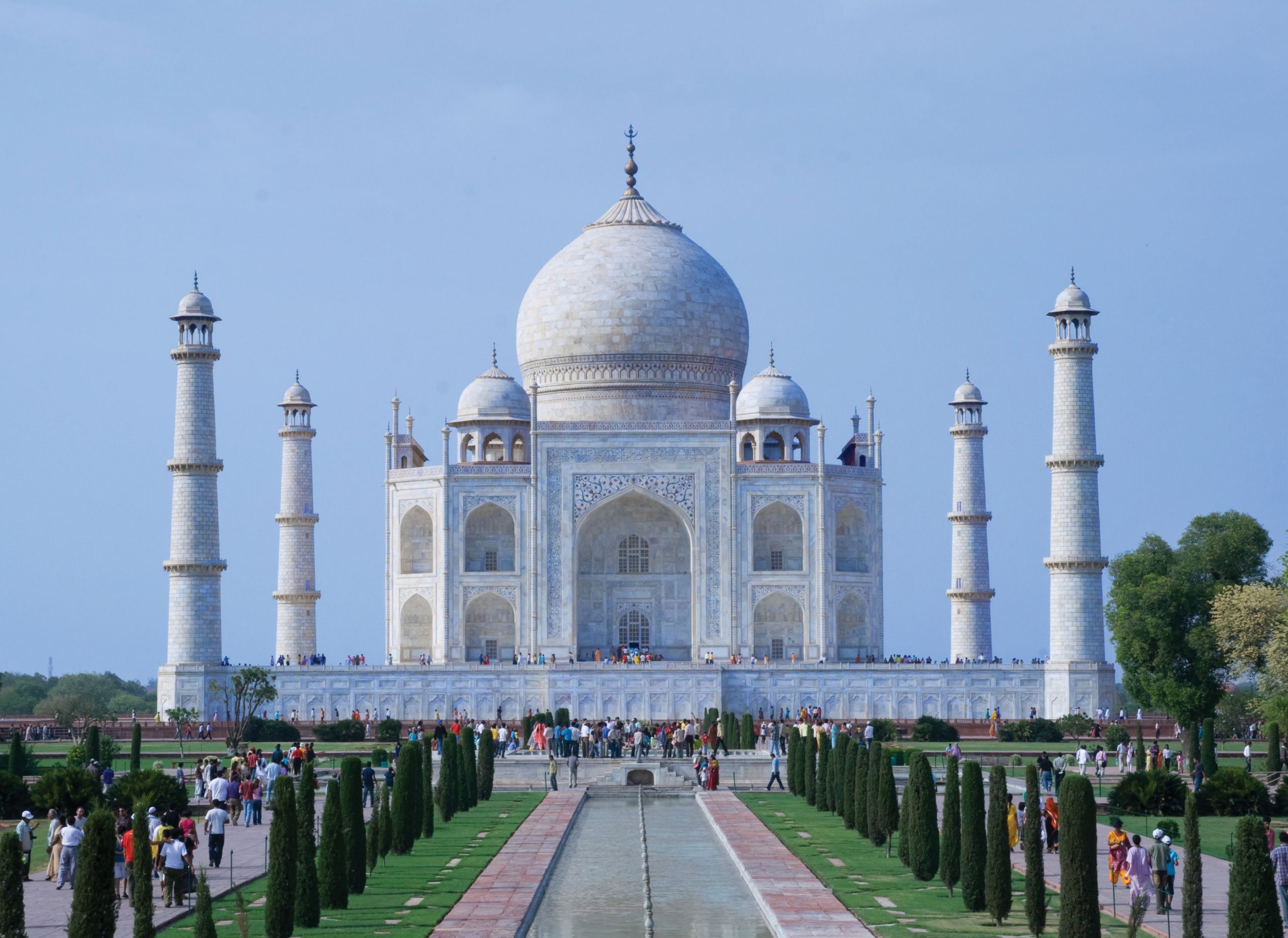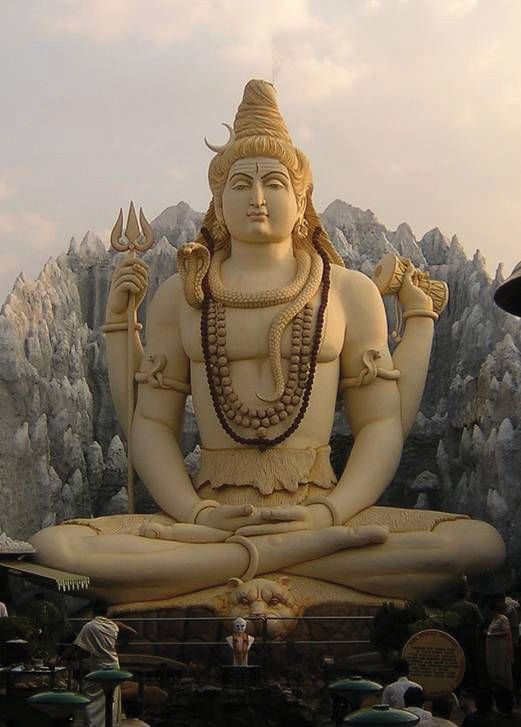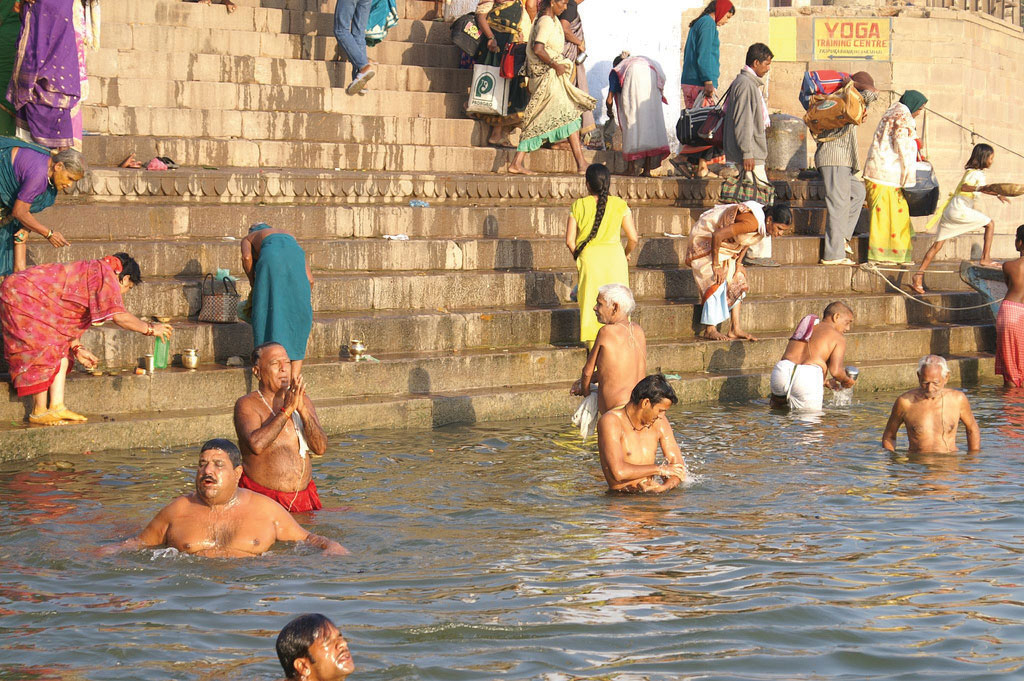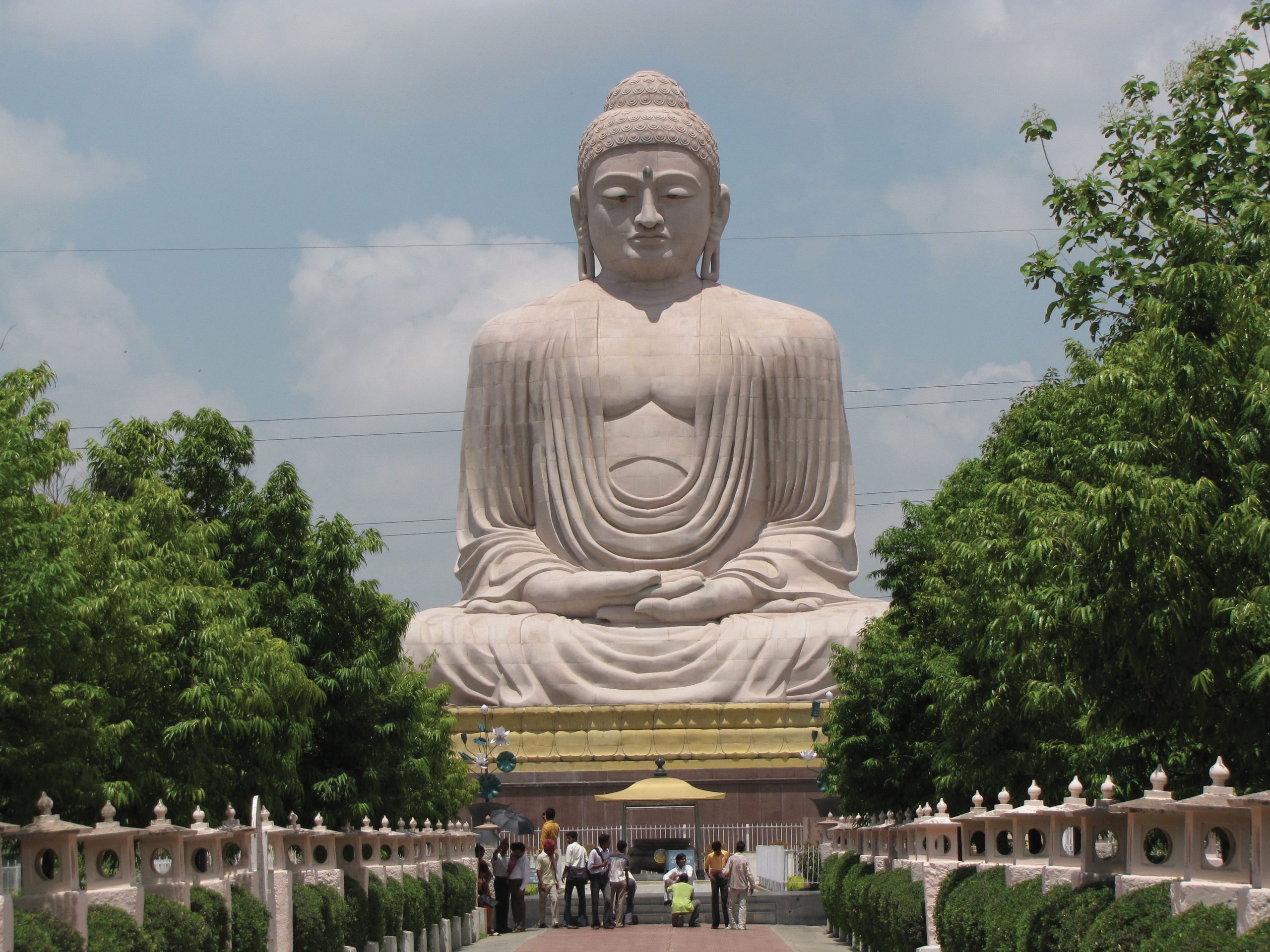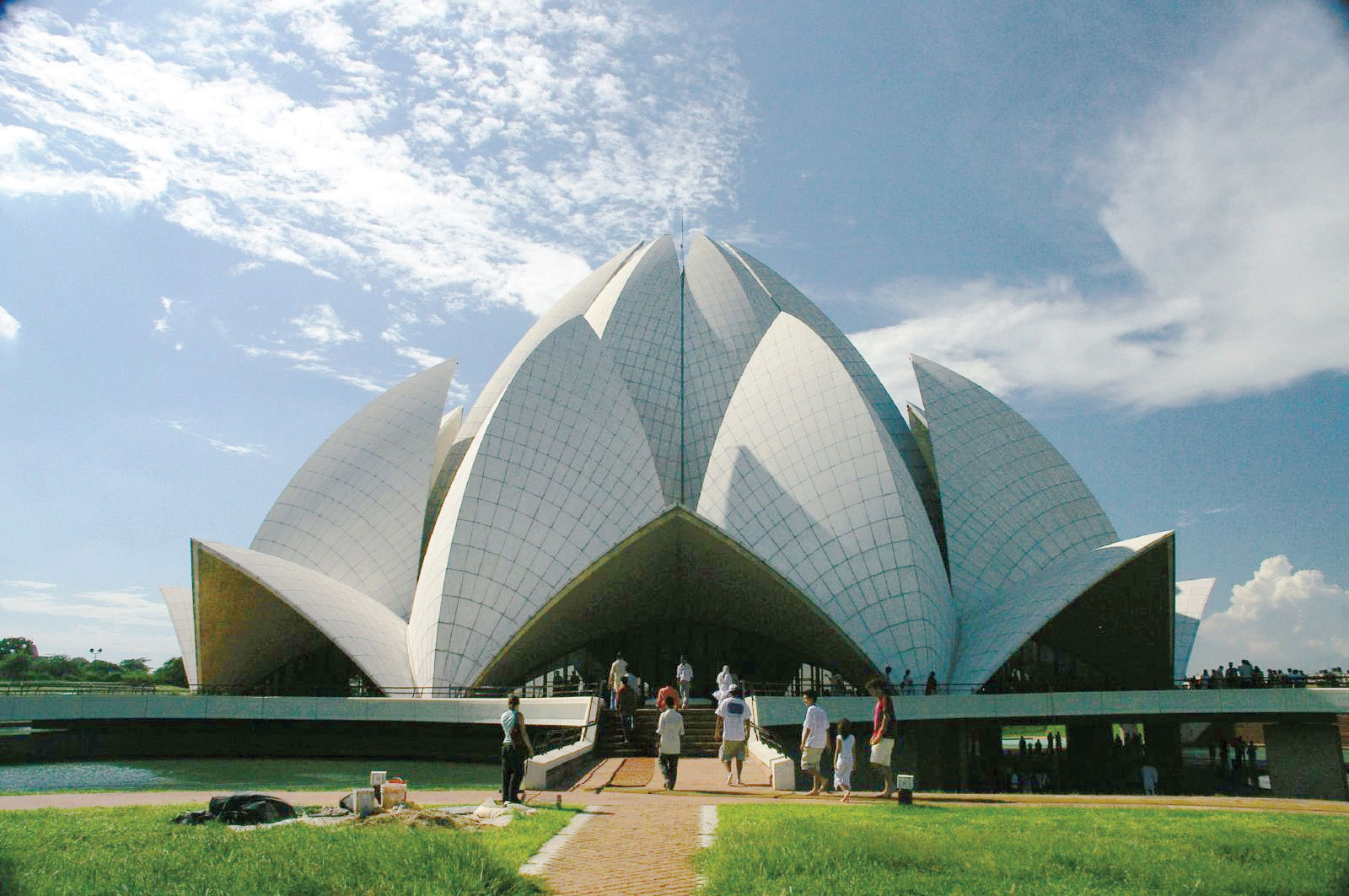Learning Objectives
- Outline the basic religions of the realm. Name the largest minority religion.
- Understand the basic structure and concepts of Hinduism, including the caste system.
- Describe how Buddhism differs from Hinduism.
- Summarize religions other than Buddhism and Hinduism that are prominent in India.
Figure 9.35 Islamic Architecture in Hindu India
The Taj Mahal was constructed as a mausoleum for the wife of the ruler Shah Jahan in 1653 when the Muslim Mogul Empire controlled northern India. The Taj Mahal is located at Agra, India, and is a UNESCO World Heritage Site.
Particlem – Taj Mahal – CC BY 2.0.
The realm of India and its surrounding countries is the native land for more than a few ancient religions. There are people in the realm who continue to adhere to animist beliefs who are not followers of any of the main world religions. The oldest world religions of India are Hinduism and Buddhism. Other important religions in the realm include Islam, Christianity, Sikhism, Zoroastrianism, Jainism, and the Baha’i faith. India is at times labeled a Hindu state, but the accuracy of the label is dubious. A more suitable way to describe India is to say that it is a secular country where approximately 80 percent of the population follows Hindu traditions. Islam is the second-most popular religion, practiced by about 13 percent of the population. Christianity is India’s third-largest religion, practiced by about 3 percent of the population. Sikhism accounts for about 2 percent of the population of India. Buddhism and Jainism are two other minority religions that have their origins in South Asia. And finally, there are still Indians who practice animist religions that predate all the other religions listed, especially in remote areas.
Hinduism
Hinduism is one of the world’s oldest major religions still practiced. Its origins can be traced to ancient Vedic civilizations in India approximately three thousand years ago. The religion is found mainly in India, and it has the third-highest number of believers of religions in the world. Hinduism does not originate from a single teacher but from many traditions. The Hindu belief system consists of a number of schools of thought, with a wide variety of rituals and practices.
Hinduism has a vast body of written scripture that discusses theology, mythology, and philosophy as well as providing important guidance on the practice of dharma, religious or right living. These texts include the Vedas and the Upanishads. Other important scripts include the Tantras, the Agamas, the Purānas, and the epics of the Mahābhārata and the Rāmāyana. The Bhagavad Gitā is a small part of the Mahābhārata that is a conversation between one of the Pandava brothers and the god Krishna, concerning the meaning of life and worthiness. This is often thought to be a summary of the spiritual teachings of the Vedas.
Predominantly, Hinduism follows the teachings of many gods or goddesses, frequently including a Supreme Being. While there are hundreds, if not thousands, of gods and goddesses, many are thought to represent different aspects of the same individual or Supreme Being. These individuals can be recognized by items that they are holding as well as by the vehicle or avatar that carries them. The three main deities and most widely venerated of the Hindu faith are Shiva the Destroyer, Vishnu the Preserver, and Brahma the Creator. There is a continuous cycle in which the original creation was accomplished by Brahma, Shiva destroys the universe, and Vishnu will recreate or preserve that universe from destruction. Different Hindu traditions have venerated each of the three main deities as the all-encompassing Supreme Being.
The polytheistic traditions of Hinduism consider a large number of deities or spiritual entities. Since there is no one creed or unified systems of beliefs, Hinduism has been referred to as more of a religious tradition than a religion. It has been said that Hinduism cannot be defined, but is instead experienced. This understanding allows a variety of beliefs to be included in the vast array of Hindu religious practices. There is actually freedom for the individual as to the form of worship or individual beliefs. The religion in general is more of a tradition and lifestyle with different avenues of practice. This allows for the diversity of spiritual deities or their manifestations within one Hindu faith.
Hinduism is an extremely diverse religion, making it extremely difficult to define set doctrines that are accepted by all denominations. Within the wide spectrum of religious traditions are general concepts that are common to Hindu beliefs. Hindus believe in Dharma (code of conduct or duty), Samsara (reincarnation/rebirth), Karma (personal actions and choices), and Moksha (salvation) by belief in God and through an individual path of faith. Reincarnation is a cycle of death and rebirth for a soul to transmigrate through until it reaches Moksha. Karma governs how the soul is reincarnated. Actions in this life determine the soul’s life cycle for the next life. Positive and upright works will draw one closer to God and a rebirth through reincarnation into a life with a wider consciousness or higher caste level. Evil or bad actions take the soul farther from God and into a lower form of worldly life or caste level. In the Hindu faith the eternal natural law applies to all life forms. The cycle of death and rebirth for the soul is necessary to reach the ultimate goal of reaching the universal divine spirit. Yoga is often used as a practice or path for following the traditions.
Pilgrimages are common in Hindu practice. Holy sites or temples are located throughout India and are regular destinations for the Hindu faithful. Pilgrimage is not required but is routinely conducted by a good number of Hindus. Besides many holy temples, a variety of cities and other holy places are pilgrimage destinations for Hindus. Varanasi, one such city, is considered by many as the holiest city of Hinduism, although other cities also hold this distinction. Located on the Ganges River, Varanasi is home to a large number of temples and shrines. The most visited shrine in Varanasi is one in honor of a manifestation of Shiva. Hindu festivals are held in Varanasi throughout the year, many along the banks of the Ganges. Varanasi is also one of the holiest places in Buddhism; it is said to have been designated by Gautama Buddha as one of four prime pilgrimage sites.
Varanasi boasts more than one hundred ghats that provide access to the Ganges River. These ghats are not to be confused with the Eastern and Western Ghats that are highland ranges located along the coasts of India. For this application, a ghat is a term for a set of steps leading to the water. Some ghats are used for bathing, some for religious rituals, and others for the cremation of the dead. More than one million Hindu pilgrims visit Varanasi annually. Mother Ganga, as the river is referred to in Hinduism, is considered holy by many Hindu followers. Devotees ritually bathe in the river or take “holy” water from it home to ill family members. Some Hindus believe that the water can cure illnesses. Others believe that bathing in the Ganges will wash away your sins. The nonspiritual truth is that the Ganges is a highly polluted waterway. The water is not considered safe for human consumption by most universal health standards.
Figure 9.37 Ghat in Varanasi, India, where Hindu Faithful Access the Ganges River
Rupert Taylor-Price – People washing at India ghats – CC BY 2.0.
Hindu Marriage Act
India’s 1955 Hindu Marriage Act addresses the issues of marrying outside of one’s religion or caste. The act proclaims that all Jains, Buddhists, Sikhs, and Hindus of any sect, creed, or caste level are considered as Hindus and can intermarry. A non-Hindu is allowed to marry a Hindu, with the provision that specific legal stipulations must be followed, regardless of the ceremony. Every Hindu marriage has to be witnessed by the Sacred Fire, in deference to Agni, the fire deity. To complete the marriage, the bride and groom must together encircle the Sacred Fire seven times.
The Hindu Caste System
The exact origins of Hinduism and the caste system are unknown, but powerful nomadic Aryan warriors appeared in northern India about 1500 BCE. The Aryans conquered most of India at the time, including the Dravidian groups of central and southern India. They organized society into separate groups or castes. Every person was born into an unchanging group or caste that remained his or her status for the rest of his or her life. All lifetime activities were conducted within one’s own caste. The caste a person was born into was considered to be based on what they had done in a past life. The caste system has evolved differently in different parts of Asia. Each Hindu branch has its own levels of castes, and thousands of sublevels have been established over time. In Hinduism, the basic system originated around five main caste levels:
- Brahmin: priests, teachers, and judges
- Kshatriya: warrior, ruler, or landowner
- Vaishya: merchants, artisans, and farmers
- Shudra: workers and laborers
- Dalits (Untouchables or Harijan): outcasts or tribal groups
The Dalits (Untouchables or Harijan) traditionally worked in jobs relating to “polluting activities,” including anything unclean or dead. Dalits have been restricted from entering Hindu places of worship or drinking water from the same sources as members of higher castes. They often had to work at night and sleep during the day. In many areas, Dalits needed to take their shoes off while passing by upper-caste neighbors. Dalits could leave their Hindu caste by converting to Christianity, Buddhism, or Islam. The Indian government has implemented a positive affirmative action plan and provided the Dalits with representation in public offices and certain employment privileges. This policy has received harsh opposition by upper-caste groups. Technically, the caste system is illegal under current Indian law. Nevertheless, the opportunities that are available to the upper castes remain out of reach to many of the lowest caste. In some areas, education and industrialization have diminished the caste system’s influence. In other areas, Hindu fundamentalists have pushed for a stronger Hindu-based social structure and opposed any reforms.
Traditional socioeconomic status tends to be more important in rural areas, where the caste system is more formally adhered to. If you live in a community of millions of people, caste affiliations tend not to be important, but in a smaller, more rural community, these relationships and the status they hold can be very important, especially as many of the castes are associated with traditional village tasks, such as religious leaders, politicians, farmers, leather workers, or other activities.
Buddhism
Around 535 BCE in northern India, a prince by the name of Siddhartha Gautama broke from the local traditions that shaped Hinduism and taught religious salvation through meditation, the rejection of earthly desires, and reverence for all life forms. Siddhartha is recognized as the first Buddha. He taught that through many cycles of rebirth a person can attain enlightenment and no longer have a need for desire or selfish interests. Enlightenment is being free from suffering and is reaching a state of liberation often referred to as Nirvana. Buddhism is considered a “dharmic” faith that concerns following a path of duty for a proper life. According to Buddhism, life is dictated by karma, which connects our actions with future experiences. Buddhism spread across the Indian Subcontinent after the sixth century BCE and became the region’s dominant religion within 1,500 years. However, since that time, the religion has diminished in the Indian Subcontinent, although it has seen some revival under the influence of Buddhist scholars. Buddhism predominates in the northernmost areas of India.
Buddhism is the majority religion in Bhutan, Sri Lanka, Tibet, and most of Southeast Asia. It was prominent in China, Mongolia, and North Korea before their governments adopted Communist ideology. Communist governments officially announced that their countries were nonreligious, although many people still followed religious systems. Various branches of Buddhism have developed, with many schools established within each branch. Buddhism can be divided geographically into southern, northern, and eastern Buddhism. Scholars and Buddhists practitioners may arrive at various methods of classification of the various schools of thought within the Buddhist faith; the geographic basis of recognition provides only one way to understand the variations within the religion. One feature common throughout all branches of the faith is that Buddhism does not have caste levels.
The southern branch of Buddhism is known as Theravada Buddhism (the Teaching of the Elders), most prominent in Southeast Asia and Sri Lanka. This branch, referred to as the oldest branch of Buddhism, attempts to follow the original Buddha’s teachings. Meditation and concentration are seen as keys to enlightenment. Spiritual forces do exist but it is up to the individual to attain his or her own path toward awakening.
The northern variety of Buddhism is associated with the Vajrayana Buddhist tradition and is often called Tibetan Buddhism. It has its strongest allegiance in Tibet, Western China, Bhutan, Nepal, and parts of Mongolia. Rooted in the Buddha’s original teaching, Northern Buddhism seeks to break out of the cycle of birth, death, and rebirth. Spiritual techniques are often used, along with the main principle of meditation. Vajrayana Buddhism is considered by some to be a branch of Mahayana Buddhism.
In the east, the main form of Buddhism is the Mahayana tradition, which is most common in Japan, Taiwan, Korea, parts of Vietnam, and eastern China. There are various forms of the eastern traditions, including Zen Buddhism. Meditative in nature, there is a strong emphasis on universal compassion, altruism, and selflessness. Considered by many to be compatible with other religions, it is often touted as more a lifestyle than a religion. The meditative activities are often said to focus on calming the body and mind, which can provide a positive outcome for anyone seeking inner direction, even those following other religions.
All branches of Buddhism teach nonviolence, honesty, selflessness, tolerance, and moral living. Buddhism holds to the Four Noble Truths and the Eightfold Path (The Middle Way) to enlightenment. Suffering is a standard component of humanity. Only through the Eightfold Path to enlightenment is freedom from suffering possible. Enlightenment comes through wisdom, ethical conduct, and meditation. Buddhism has become the world’s fourth main religion, with most of its followers in Asia.
The Four Noble Truths and the Eightfold Path
The Four Noble Truths
1. Suffering exists.
2. Suffering arises from attachment to desires.
3. Suffering ceases when desire ceases.
4. Freedom from suffering is possible by practicing the Eightfold Path.
The Middle Way or Eightfold Path
Attainable through wisdom
1. Right view
2. Right intention
Attainable through ethical conduct
3. Right speech
4. Right action
5. Right livelihood
Attainable through meditation
6. Right effort
7. Right mindfulness
8. Right concentration
Other Religions of South Asia
Islam
Islam diffused to South Asia from the Middle East through traders and merchants shortly after its creation. The Mogul Empire dominated northern India for centuries and is an example of the Islamic presence in the region. India has the largest Muslim minority in the world. In 2010, India had an estimated population of 140 million Muslims, which made up about 14 percent of the population. India has the third-largest Muslim population in the world, after Indonesia and Pakistan. Most Muslims in India live in the north along the Ganges River Basin and in Nepal. There is also a large Muslim population in eastern India near the border with Bangladesh. Kashmir, in northern India, also continues to hold a significant Muslim population.
Christianity
Christianity is India’s third-largest religion, practiced by about 3 percent of the population. Christianity is a monotheistic religion following the teachings of Jesus Christ that originated in the Middle East. Tradition has it that Christianity first came to India through first-century CE missionary activity linked to the Apostle Thomas, and later arrived to other parts of India through the activities of western missionaries from 1500 CE onward. A major Christian stronghold is the state and city of Goa on the southwest coast, a colony of Portugal from the 1500s to the mid-1900s. There is also a strong Christian presence in eastern India, in the region bordering Myanmar.
Jainism
Jainism or Jain Dharma is a spiritual, religious, and philosophical tradition in India that dates back to about the ninth century BCE. Jains (followers of Jainism) believe that their religion’s origins extend back to the distant past. A Jain is a follower of Jinas (the saints), who are humans who have rediscovered the dharma (or the way) and have become fully liberated. These Jinas can then teach this spiritual path to other people. A major characteristic of Jainism is the emphasis on the consequences of physical and mental behavior. There are about five million Jains in India, and others around the world.
Great care must be taken while going about one’s daily life, as Jains believe that everything is alive and that many beings (including pests such as insects) possess a soul. All life is considered worthy of respect and all life is equal and deserves protection, especially the life of the world’s smallest creatures. While in India, you can recognize Jains, because many of the strictest adherents will wear masks to prevent themselves from inhaling insects and thus destroying the insects’ souls. Jains are a religious minority, with around five million followers in modern-day India.
All followers of Jainism are vegetarians. Their diet is part of the practice of nonviolence at the heart of their religion. They will eat only food items such as fresh fruit, vegetables, cereals, and legumes. Most root vegetables such as potatoes and onions are avoided by the more devout because of the harm that would be done to the plants themselves or other organisms in the soil when the roots are pulled. Additionally, Jainists will not eat honey, consume any food that may have fermented overnight, or drink water that has not been filtered.
Sikhism
Sikhism was previously discussed in the section on the Punjab, the region at the center of the Sikh community. Sikhism is a monotheistic religion centered on justice and faith. In Sikhism, salvation can be obtained through devotion to God and through disciplined meditation. There is a high importance placed on the principle of equality between all people in the Sikh religion. There should be no discrimination on the basis of gender, creed, caste, or ethnicity; every person is equal. The writings of former Sikh gurus are the basis for the religion. The center of the Sikh religion is found in the Golden Temple, in the city of Amritsar, in the Punjab. This is where Sikhs gather to unite in the faith and associate with each other. There are about twenty-six million Sikhs in the world, and about three-fourths of them live in the Punjab state of India.
Baha’i Faith
Figure 9.41 Baha’i Faith’s Lotus Temple in New Delhi
India has the largest population of Baha’i in the world.
Wikimedia Commons – CC BY 2.0.
The Baha’i Faith is found in many large urban areas of the Indian Subcontinent, particularly New Delhi, where a large temple complex is found. This temple is commonly known as the “Lotus Temple” based on its shape, which looks like a large lotus flower. Two million Baha’is live within India, which has the largest population of Baha’is in the world. Iran has the second-highest Baha’i population in the world. There is also a major Baha’i temple and center in Haifa, Israel. The Baha’i Faith was founded by Baha’u’llah in Persia (Iran) during the nineteenth century CE. This religion focuses on the spiritual oneness of humanity and the unity of the other major world religions.
Zoroastrianism
Zoroastrianism originated in Iran (or Persia); in fact, it was once the dominant religion of Greater Iran, but it has now dwindled to about two hundred thousand Zoroastrians around the world, with concentrations in Iran, India (primarily Mumbai), and Pakistan (primarily Karachi and Lahore). Zoroastrianism follows the teachings of the prophet Zoroaster (also known as Zarathustra or Zarthosht). This philosophy acknowledges the divine authority of Ahura Mazda (Mazdaism) as proclaimed by Zoroaster. One of the tangible forms of this religion is the use of fire as a purifying agent in ceremonies. The temples are commonly known as “fire temples.” Additionally, because of a prohibition of burials of bodies in the ground, Zoroastrians allow natural exposure of bodies to the elements in structures known as “Towers of Silence.” The greatest numbers of followers of Zoroastrianism can be found in India, with additional numbers in southern Pakistan.
Key Takeaways
- Hinduism is one of the world’s oldest still-practiced religions. There is no one specific path in the religion. Hinduism is more of a religious tradition based on core concepts than it is a formal religion.
- The caste system is a Hindu practice of placing people in social layers with similar occupations, privileges, and status. The untouchables are the lowest caste.
- Buddhism was created around 535 BCE from the traditions that shaped Hinduism by Siddhartha Gautama, who taught religious salvation through meditation, the rejection of earthly desires, and reverence for all life forms. There is no caste system in Buddhism, which has a number of branches that vary throughout Asia.
- Islam and Christianity are the second- and third-largest religions in India but did not originate in South Asia. Jainism and Sikhism got their start in South Asia and are still practiced by millions of people. The Baha’i Faith and Zoroastrianism are also active in India.
Discussion and Study Questions
- What are the major religions in India in terms of population percentage?
- What are four of the main concepts of Hinduism? How is yoga related to Hinduism?
- Who are the three main deities in the Hindu tradition? What are each of these three associated with?
- Is the caste system a centripetal force or a centrifugal force? In other words, does it divide or unite India?
- What is the relationship between Hinduism and the Ganges River? What are ghats used for?
- What is the caste system based on? How does one become a member of a caste level?
- Does the United States have a caste system? What other countries or groups have caste-type levels?
- What is the difference between Hinduism and Buddhism? Who started Buddhism, and when?
- What are the three main branches of Buddhism, based on geographic location?
- What are the general aspects of Jainism? How is this religion different from Islam?

